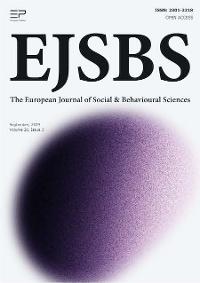Abstract
The purpose of the study is to research how music is learned in a web-based learning environment. The users of a web-based learning environment were asked to perform a self-assessment about their music learning. The research question was to determine which kind of learning experiences students had when studying music in a web-based learning environment. The other aim was to discover the students’ main interests in their music studies and the kinds of support they needed for their web-based learning. Finally, the users were asked to suggest some ways to develop a digital learning environment of music. The data was collected by using an e-questionnaire that was open for all users who studied on a Finnish web-based music learning environment during one study year. Data from 82 respondents was analysed using content analysis and the results are presented through quantitative tables and figures with qualitative results obtained from the content analyses of answers to open-ended questions. According to the results, most of the users found that the motivation to study music increased during the studies. Preferences of learning methods were individual but most of the respondents hoped web-based learning environment could be developed together with blended learning settings where web based learning and contact lessons could be integrated. The individual support from a web teacher and a peer community were also needed.
Keywords: Web based learning, music education, self-directed learning, self-assessment
Introduction
The use of digital learning environments in music education has increased and developed rapidly in recent years. Finnish teacher educators have studied the use of web-based learning environments in music education and developed blended learning settings for it (Ruokonen & Ruismäki, 2016a; Hietanen, Ruokonen, Ruismäki, & Enbuska, 2016; Tuisku & Ruokonen, 2017; Ruokonen et al., 2017; Sepp et al., 2019). These articles have focused on studying student teachers and their web-based music learning during their teacher education programme. The results have been encouraging for the further development of these learning environments. For example, according to students’ feedback, the blended strategies enhanced their engagement and music learning through online activities in the music course and improved effectiveness and efficiencies by reducing lecture time. Furthermore, this format allowed them time for group work to produce creative ideas and even permitted them to learn to play instruments that were not originally part of their curriculum plan (Hietanen et al., 2016).
In the future, the traditional distinction between class time and non-class time will disappear. The Net generation is using technologies that engage both individual and collaborative forms of learning to socialize, work and learn. Students will take online courses and blend their professional careers and personal life in a mosaic of lifelong learning activities (Dew, 2010). Technology-based music learning should provide rich online resources for collaborative learning as well as individual skills and knowledge building. Web-based learning environments also provide new lifelong opportunities to share and learn diverse cultural ideas during the processes of creation and innovation (Leong, 2012).
A web-based learning environment offers a unique informal platform for lifelong learning in music and this article focuses on lifelong learning and the aim is to study how the users think about their music learning in a web-based learning environment, who they are and how they would like to develop web-based learning settings. The data on which this article is based has been gathered through the distribution of an e-questionnaire that was open for one semester for all users who wanted to self evaluate their music learning in a web-based learning environment and participate in the research.
Theoretical Background
Self-directed and lifelong learning
A human’s ability to learn in a self-directed way creates a base for lifelong learning, which is not a new concept in education. For ages, there has been lifelong learning from older generations as well as cross-age learning (Myers, 1995). The recent focus on lifelong learning is connected to the so-called Net generation that uses digital technology in everyday life and learning. Adult learners have also recently expressed interest in the potential of informal and personal learning environments
According to Ryan and Deci (2000), intrinsically-motivated behaviours, the prototype of self-determined actions, stem from the self but extrinsically motivated actions can also become self-determined as individuals identify with and fully assimilate their regulation. The commitment is likely to be evident when individuals experience support for competence, autonomy and relatedness to their activity or studies. Liu, Wang and Ryan (2016) found in their studies that students taught by autonomy-supportive teachers had significant positive changes in perceived autonomy support, needs, self-efficacy, self-regulated learning and grades.
For learning, adults like children need intention and readiness to learn, intrinsic motivation, positive reinforcement, sequencing, meaningfulness and a connection to learner goals and interests. However, the ways of learning, strategies and techniques for achieving the learning goals differ with adult learners. According to Brookfield (1992), adult learners are more voluntary learners who like to learn in a self-directed and empowered way. Effective learning combines learning in respective and collaborative settings with the right combination of critical reflection and action.
According Merriam (2001), there are two important mosaic pieces of theories, explanations or principles that combined explain the knowledge base of adult learning: andragogy and self-directed learning. Knowles (1980), a theorist of andragogy, describes five assumptions of the adult learner as a learner who first has an independent self-concept and can direct his/her own learning. Second, the adult learner has a previous life experience that is a rich resource for all new learning. Third, an adult learner’s need to learn is closely connected to changing social roles. Learning is problem-centred and the adult learner is interested in the recent application of knowledge. Finally, the adult learner is motivated to learn by internal rather than external aspects.
There has been much discussion and critics of andragogy focus on the point that every individual is shaped by his/her society and culture, which affects learning and social institutions and structures define the learning transaction irrespective of the individual learner (Grace, 1996 p.383).
According to Pratt (1993) and Merriam (2001), andragogy has contributed to the understanding of adults as learners but it has not helped to understand or clarify the process of learning nor has it achieved the status of a theory of adult learning. Learner’s autonomy usually varies from one situation to another and educators should not assume the same kind of self-directed orientation from adult learners occurs in every situation. Support and guidance may be needed especially in the first stages of a learning project.
At the same time, the principle of self-directed learning was created to further understand adult learners. Mezirow’s (2000) theory of transformational learning is connected to self-directed learning focusing on critical reflection as a central issue in a learning process. Mezirow (2000) understands critical reflection as the historical, cultural and biographical reasons for a learner’s needs and motives to learn. According to Mezirow (2000), such self-knowledge is essential for autonomy in self-directed learning and the aim of adult education is to support and assist adult learners to strengthen their capability to grow as self-directed learners.
Merriam (2001) has also assessed self-directed learning in adult education and suggested several areas for future research. First, the process of learning and individual learning paths should be studied. Some adults remain self-directed in their learning over extended periods of time. More research is needed about how the learning process develops as learners move from novice to expert in their knowledge or skills. Other interesting issue would be to explore how a self-directed learner can have an impact on the instructional and planning activities of different learning environments or how self-directed learning affects educational policy.
Adult learners have individual needs especially if the learning is connected to their free time activities. According to Attwell (2007), a personal learning environment (PLE) focuses on continuous learning and seeks new tools to support each individual learner in informal and formal learning settings. A personal learning environment includes a combination of different tools that an individual uses in everyday life for learning. A web-based learning music environment can be one part of this kind of PLE.
New learning environments in music education
Digital and informal learning environments have recently rapidly increased in music education. Green (2002) has focused on the significant potential of informal and digital learning environments and communities of young musicians. For example, they teach themselves to play music into which they are encultured by studying the music and style through listening and copying recordings, learning from the Web and sharing their knowledge and skills with peers. In these self-directed learning settings commitment, enjoyment and even passion have been documented in research.
Partti (2012) has studied musical learning and identity work in digital learning environments. The findings show that digital music and information technology can open wider possibilities for musical learning. Digital learning environments break boundaries between expertise and amateur and different genres and roles of music making. This is seen as a celebration of simultaneous global and local communities for pursuing social and individual identities in more open ways. According to Partti (2012), this manifests a new democratic revolution that provides individuals options for their personal musical growth and expression.
According to Leong (2011), future music education should pay more attention to lifelong musical exploration and learners who have been underserved in the past to engage whole communities in learning music. Learning environments should support learning activities that balance physical, cognitive, metacognitive and social elements, utilize new technologies and integrate music into the daily life of learners and promote lifelong learning.
Web-based teaching and learning changes pedagogy in a way that emphasises the teacher’s role as an instructor or a guide (Ruokonen & Ruismäki, 2016b). According to Ruippo (2015), in web-based teaching, empathy needs to be emphasised and video-based methods are natural tools for web-based teaching.
In the case of this study, the digital web-based learning environment is designed for self-directed learners who are willing to create their personal learning pathway in music according to their individual interests and needs. The web-based learning environment consists of several pathways of musical learning at different stages from beginner and novice lessons to the special interests of the experts. The selection of music lessons varies and consists of music theory, instrumental lessons, voice development, composition and creative production. Every individual can plan a learning pathway and select lessons for study.
Research questions and design
The purpose of the study is to research how music is learned in a web-based learning environment. The users of a web-based learning environment were asked to self-assess their music learning in a web-based environment. The research question was first to determine the self-directed users of a music learning environment. Secondly, the aim was to learn about the learning experiences users had when studying music in a web-based learning environment. The third aim was to find discover the students’ main interests in their music studies and which kind of support they needed for their web-based learning. Finally, the users were asked to suggest how they would develop a digital music learning environment. The data was collected using an e-questionnaire that was open for all users who studied in a Finnish web-based music learning environment during one study year. Data of 82 respondents was analysed using content analysis and the results are presented through quantitative tables and figures with qualitative results from the content analyses of the responses to the open-ended questions.
Results and Discussion
The first aim of the study was to determine who were the users of this web-based music learning environment. Altogether 82 users (55 women and 27 men) responded to the questionnaire during one semester 2018-19. This is only a small number of all possible users but it provides an example of the users’ profile and experience. Users came from all age groups but most of them (41.46%) were between 40 to 65 years old. The other users were 26-40 years old (29.27%); over 65 years old (17.07%); 19-25 years old (9.76%) and only 2.44% under 18 years old. Most of the respondents were working (62.2%). The other respondents were retired (14%), students (18.3%) and 2.4% were school children and were 2.4% unemployed persons.
Only 7.3% of the respondents had never had music as their hobby. Most of the respondents (48.8%) had continued music activities as their hobby over 20 years which proves their need for lifelong learning in music. Only 11% of the respondents had previous music school background and most of them had used only informal learning opportunities to learn music during their life. The web-based learning environment was also familiar to 19.5% of the respondents, who had already been users of this type of learning environment for some years.
The web-based learning environment offered users many ways in which to study music at the same monthly user price but in spite of the same price most users concentrated on only one or two instruments or other music learning areas they were eager to learn. Nevertheless, many of them also occasionally tried and became familiar with some new areas of musical learning (see Table 1).
Most of the respondents were really learning new skills and achieving new knowledge in music and especially music theory. Most of them had not studied music at a music school level so this might explain their positive learning experiences in music theory (see Fig. 1).
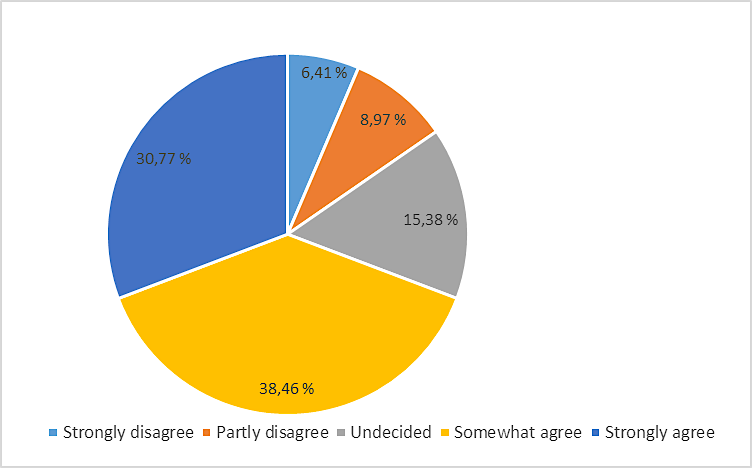
According to the results, the users gained many new musical ideas for their music making (see Fig. 2). According to their open responses, these new creative ideas were important for them to develop their instrumental playing especially in free accompaniment.
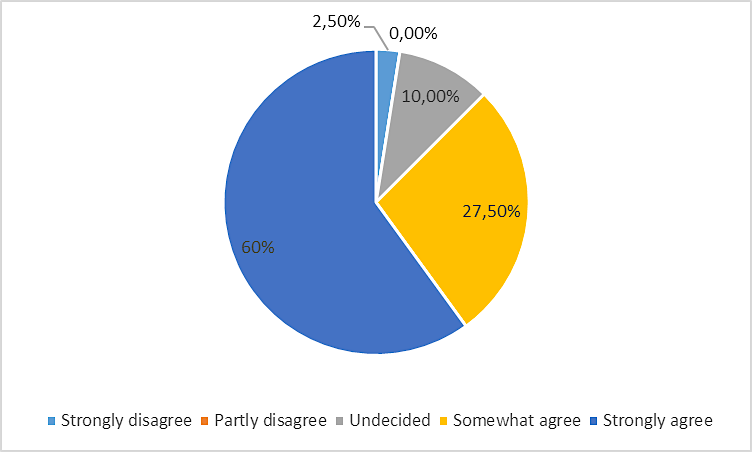
Although most of the users had previously had music as their hobby before using the web-based learning environment, they did not choose to study only the instruments with which they were familiar but were also eager to learn new instruments (see Fig. 3). The most popular instrument studied was guitar but keyboard, drums, bass and ukulele were also frequently mentioned as being part of their repertoire of study (see Table 1).
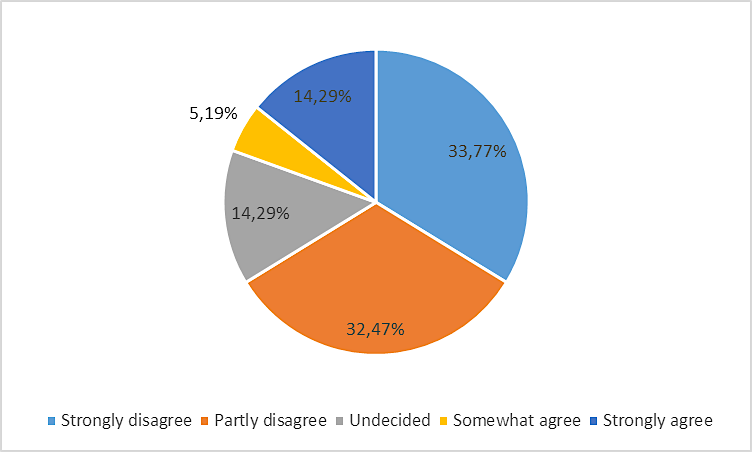
Studying in a web-based learning environment during the leisure time of the users shows that the users were generally motivated to learn music in self-directed way and the new learning environment is not strongly improving this motivation. Still 43.59% of the users somewhat agree that their motivation for music learning has increased in web-based learning environment (see Fig. 4).
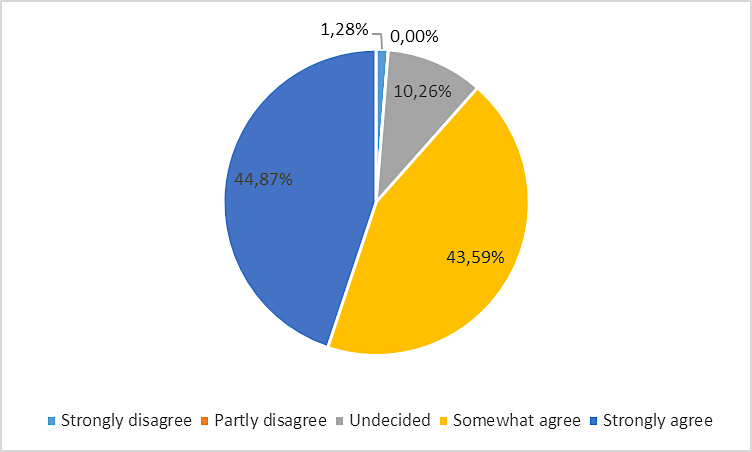
All users had experiences of Finnish school music education. When they were asked to evaluate and compare the different kind of learning settings, most of them could not offer an opinion about any of the choices given. Many of them valued the blended learning environment where web-based music learning is connected to supportive contact lessons. The learning environments where personal needs are recognised and support is offered in a web-based environment was valued among the users (see Table 2). The users also greatly valued the web-based learning opportunity because through the digital environment music learning was not connected to any specific time or place of contact lessons.
The users were eager to give their ideas for developing a web-based environment. The developmental ideas were asked in open-ended questions and the analysed data could be classified in three pedagogical themes. First, users had a need for individual support in their learning and planning the study pathways in a web-based environment as several learners noted:
Secondly, the users commented on the development of technical solutions: “I miss a two camera technique, where both hands could be seen at the same time when studying guitar playing; It would be wonderful to have possibilities to document my own musical products or songs in different phases from prototype to the final version.”
The third theme consists of different individual wishes that were connected to the support, payments and material offered on different study levels:. According to the analysed material in terms of their age and previous musical activities, it can be seen that most of the respondent users have continued their musical activities and learning in a web-based environment. Only two of the users had some professional studies in music; all the others were studying music as their personal free time activity interest. The users had many ideas about how to develop the digital learning environment. Although they valued the individual learning timetable and opportunity to learn wherever and whenever, many users wanted to develop web-based learning environment as a more interactive platform of learning. Support, guidance and mentoring was needed to blend different educational aspects into the web-based learning environment.
Conclusion
Over a decade ago, Salavuo (2008) promoted the idea that web-based learning environments and networks of creative people could function as a basis for life-long learning. For future music education, this means online presence and development of more interactive web-based music learning environments where participation and even ownership is possible for users’ own learning environments. This case study also proves the necessity of developing lifelong learning music environments where users can learn music without any limitations of place or time to participate. For educational institutions and entrepreneurs, this means new challenges to create and develop new technological solutions for promoting various learning options, blended learning settings, individual support, peer- or teacher-mentoring in a web-based learning environment for users’ lifelong musical learning.
New digital web-based learning environments enrich learning experiences and at best, can motivate deeper, informal lifelong music learning. In the future, new web-based lessons can be developed by educational institutions and entrepreneurs like Rockway and Yousician as has already been done in Finland. In institutional music education it is important to note that formal music learning benefits from web-based digital environments. In the future, the interaction between formal and informal learning and potential during lifelong music learning should be more extensively researched. The role of an expert facilitator or designer of web-based learning environments should also be developed and studied. In addition, the need for support and didactics to teach self-directed learning methods for adult learners in various learning environments should be developed and researched.
References
Attwell, G. (2007). Personal Learning Environments-the future of eLearning. E-learning papers, 2(1), 1-8.
Brookfield, S. (1992). Why can't I get this right? Myths and realities in facilitating adult learning. Adult Learning, 3(6), 12-15.
Dew, J. (2010). Global, mobile, virtual, and social: The college campus of tomorrow. The Futurist, 44(2), 46–51
Grace, A. P. (1996). Taking a Critical Pose: Andragogy - Missing Links, Missing Values. International Journal of Lifelong Education, 15(5), 382–392.
Green, L. (2002). How popular musicians learn: A way ahead for music education. London: Routledge.
Hietanen, L., Ruokonen, I., Ruismäki, H., & Enbuska, J. (2016). Student Teachers’ Guided Autonomous Learning: Challenges and Possibilities in Music Education. Procedia - Social and Behavioral Sciences, 217, 257-267.
Knowles, M. S. (1980). The modern practice of adult education: From pedagogy to andragogy. Englewood Cliffs, NJ: Cambridge Adult Education.
Leong, S. (2012). Navigating the emerging futures in music education. Journal of Music, Technology & Education, 4(2-3), 233-243.
Liu, W. C., Wang, J. C. K., & Ryan, R. M. (2016). Understanding motivation in education: theoretical and practical considerations. In W. C. Liu, C. K. Wang, & R. M. Ryan (Eds) Building autonomous learners: Perspectives from Research and Practice using Self determination Theory (pp. 1-7). Springer, Singapore.
Merriam, S. B. (2001). Andragogy and self‐directed learning: Pillars of adult learning theory. New directions for adult and continuing education, 2001(89), 3-14.
Mezirow, J. (2000). Learning to think like an adult: Core concepts of transformation theory. In J. Mezirow (Ed.) Learning as transformation (pp. 3-34). San Francisco: Jossey-Bass
Myers, D. E. (1995). Lifelong learning: An emerging research agenda for music education. Research studies in music education, 4(1), 21-27.
Partti, H. (2012). Learning from cosmopolitan digital musicians: Identity, musicianship, and changing values in (in) formal music communities. Studia Musica 50. Helsinki: Sibelius-Academy.
Pratt, D. D. (1993). Andragogy After Twenty-Five Years. In S. B. Merriam (Ed.), Update on Adult Learning Theory. New Directions for Adult and Continuing Education, no. 57, San Francisco: Jossey-Bass.
Ruippo, M. (2015). Online Teaching of Music. Synthesis Report of the Sibelius Academy Regional Development Project 2001-2003 and its subsequent development of e-learning. Retrieved from https://www.academia.edu/638541/Musiikin_verkko-opetus_ja_aluekehitys
Ruokonen, I., Enbuska, J., Hietanen, L., Tuisku, V., Rimppi, A., & Ruismäki, H. (2017). Finnish student teachers’ self-assessments of music study in a blended learning environment. Finnish Journal of Music Education, 20(2), 30-39.
Ruokonen, I., & Ruismäki, H. (2016a). E-Learning in Music: A Case Study of Learning Group Composing in a Blended Learning Environment, Procedia: Social and Behavioral Sciences, 217, 109-115.
Ruokonen, I., & Ruismäki, H. (2016b). Beyond the Classroom: Future Music Education through Technology. In H. Niemi & J. Jia (Eds.). New Ways to Teach and Learn in China and Finland: Crossing Boundaries with Technology (pp. 55-75). Frankfurt am Main: Peter Lang.
Ryan, R. M., & Deci, E. L. (2000). Self-determination theory and the facilitation of intrinsic motivation, social development, and well-being. American psychologist, 55(1), 68.
Salavuo, M. (2008). Social media as an opportunity for pedagogical change in music education. Journal of Music, Technology & Education, 1(2-3), 121-136.
Sepp, A., Hietanen, L., Enbuska, J., Tuisku, V., Ruokonen, I., & Ruismäki, H. (2019). University Music Educators Creating Piano-Learning Environments in Finnish Primary School Teacher Education. The European Journal of Social & Behavioural Sciences, 24(1), 2852-2864.
Tuisku, V., & Ruokonen, I. (2017). Toward a Blended Learning Model of Teaching Guitar as Part of Primary Teacher Training Curriculum. European Journal of Social and Behavioural Sciences, 20, 2520-2537.
Copyright information

This work is licensed under a Creative Commons Attribution-NonCommercial-NoDerivatives 4.0 International License.


